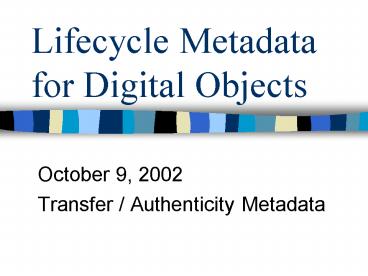Lifecycle Metadata for Digital Objects PowerPoint PPT Presentation
1 / 14
Title: Lifecycle Metadata for Digital Objects
1
Lifecycle Metadata for Digital Objects
- October 9, 2002
- Transfer / Authenticity Metadata
2
Transferring paper records
- Records Center Storage Approval Form
- Agency approval signature
- Description of materials
- Approval Number received for transmission
- Pack and label correctly (agreed standard)
- Use proper boxes
- Label with identifiers
- Pack in original order and approved arrangement
- Number boxes in batch
- Stack correctly
- Transmittal Form for batch
- Digest of contents
- Access Codes received for boxes
3
The central problem Security guaranteeing
Authenticity
- Guarding the object (authenticity, integrity)
- Proving the identities of the people responsible
for transferring the object (authentication,
non-repudiation) - Transferring the object in a secure way
4
Cutoff for the digital object The moment of
recordness
- Assertion that the object is complete (cf. UBC)
- Assertion that it is an archivable object
- Assertion that the asserter has the authority to
enact cutoff - All these assertions may be system-supplied in
the digital environment - user logins
- user role ID
- identity of the workstation on the network
5
What is transfer about?
- What is a digital copy? What qualifies?
- Data compression issues
- Data segmentation issues
- Creating application vs file-management
application - How can a digital copy be guaranteed?
- Digital object as string of bits
- Message digest of object as math on the bits
- Ship the message digest with the object
- Recalculate and compare at the other end
6
Moving from user to repository
- Using the public network securely
- Sending from user to repository
- VPN
- SSL
- Secure drop-box technology
- Separate hardened server (between DMZs)
- Only A can deposit, only B can withdraw
- Repository harvests objects from users drop-box
7
Proving the identity of the sender
(Authentication I)
- Assymetrical encryption
- Private/public keys reverse purposes
- Private one (only)
- Public many (every)
- Digital signature
- Calculate message digest
- Use one of asymmetric key pair to transform
- If recipients public key, only recipient can
decode - If senders private key, only sender can have
sent - Use second of assymetric key pair to decrypt
- Check message digest against message
8
Proving the identity of the sender
(Authentication II Non-repudiation)
- Certification (PKI, XKI)
- Connecting keys with individual
- External or internal
- Endurance
- System permissions and activity
- Data collected from system/network operations
logs - Necessity for collecting as archival!
9
Guaranteeing the authenticity of the object
(Integrity)
- Object as open or secret
- Must we disguise the object?
- Can we move it around in clear?
- Message digest
- Creates single number one-way hash
- Number will change with the slightest change in
the object on which it was calculated - Encryption (Confidentiality)
- Asymmetric
- Symmetric
10
Proving the identity of the receiver
- Digital signature
- System permissions
- Recorded as part of repository operations records
11
Documenting the transfer
- Time-stamps
- System logs
12
Verifying the transfer
- Quality control
- Verifying the message digest
- Checking the object against the wrapper
13
XML and partial signing
- XML wrapper for a set of objects permits
individual or multiple objects to be signed - Objects can potentially be signed by different
people in workflow - This means that a born-digital XML-wrapped object
may already contain several digital signatures
from different sources - May require verification and resigning as single
object by record-asserting entity before transfer
14
XML Signature
- ltSignaturegt
- ltSignedInfogt
- (CanonicalizationMethod)
- (SignatureMethod)
- (ltReference (URI)?gt
- (Transforms)?
- (DigestMethod)
- (DigestValue)
- lt/Referencegt
- lt?SignedInfogt
- (SignatureValue)
- (KeyInfo)?
- (Object)
- lt?Signaturegt

